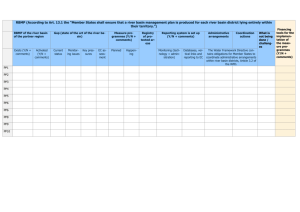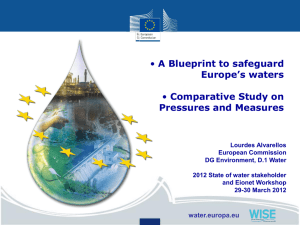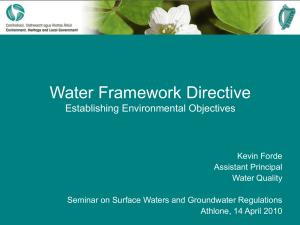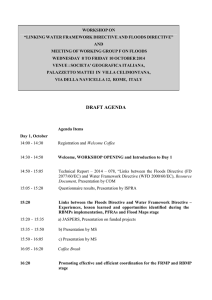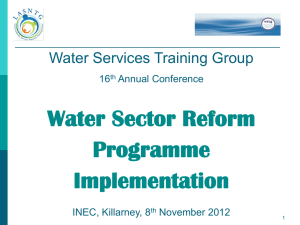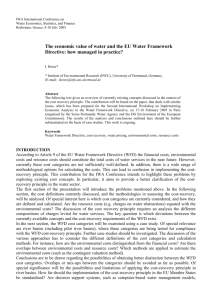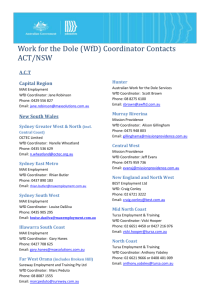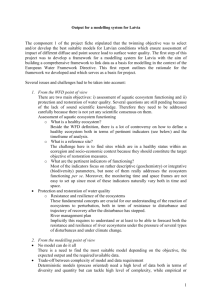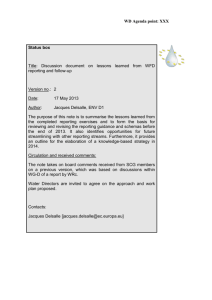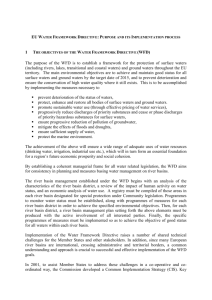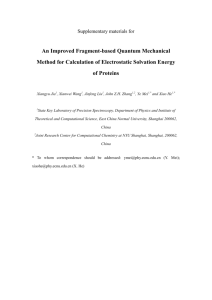Implementation of the Water Framework Directive
advertisement
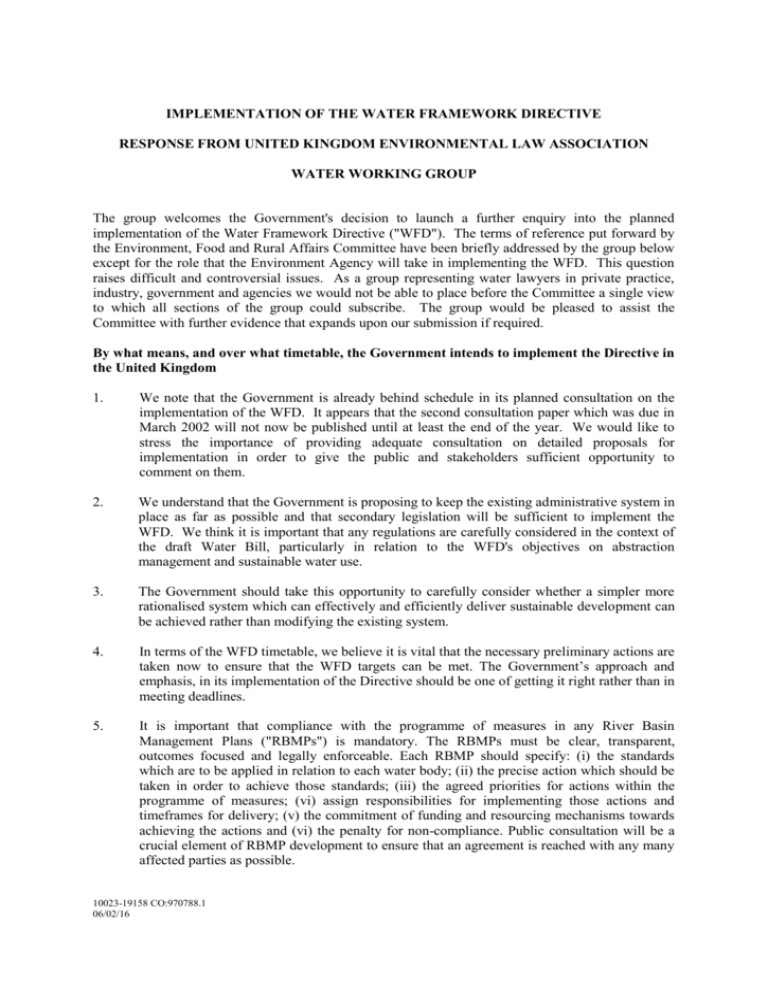
IMPLEMENTATION OF THE WATER FRAMEWORK DIRECTIVE RESPONSE FROM UNITED KINGDOM ENVIRONMENTAL LAW ASSOCIATION WATER WORKING GROUP The group welcomes the Government's decision to launch a further enquiry into the planned implementation of the Water Framework Directive ("WFD"). The terms of reference put forward by the Environment, Food and Rural Affairs Committee have been briefly addressed by the group below except for the role that the Environment Agency will take in implementing the WFD. This question raises difficult and controversial issues. As a group representing water lawyers in private practice, industry, government and agencies we would not be able to place before the Committee a single view to which all sections of the group could subscribe. The group would be pleased to assist the Committee with further evidence that expands upon our submission if required. By what means, and over what timetable, the Government intends to implement the Directive in the United Kingdom 1. We note that the Government is already behind schedule in its planned consultation on the implementation of the WFD. It appears that the second consultation paper which was due in March 2002 will not now be published until at least the end of the year. We would like to stress the importance of providing adequate consultation on detailed proposals for implementation in order to give the public and stakeholders sufficient opportunity to comment on them. 2. We understand that the Government is proposing to keep the existing administrative system in place as far as possible and that secondary legislation will be sufficient to implement the WFD. We think it is important that any regulations are carefully considered in the context of the draft Water Bill, particularly in relation to the WFD's objectives on abstraction management and sustainable water use. 3. The Government should take this opportunity to carefully consider whether a simpler more rationalised system which can effectively and efficiently deliver sustainable development can be achieved rather than modifying the existing system. 4. In terms of the WFD timetable, we believe it is vital that the necessary preliminary actions are taken now to ensure that the WFD targets can be met. The Government’s approach and emphasis, in its implementation of the Directive should be one of getting it right rather than in meeting deadlines. 5. It is important that compliance with the programme of measures in any River Basin Management Plans ("RBMPs") is mandatory. The RBMPs must be clear, transparent, outcomes focused and legally enforceable. Each RBMP should specify: (i) the standards which are to be applied in relation to each water body; (ii) the precise action which should be taken in order to achieve those standards; (iii) the agreed priorities for actions within the programme of measures; (vi) assign responsibilities for implementing those actions and timeframes for delivery; (v) the commitment of funding and resourcing mechanisms towards achieving the actions and (vi) the penalty for non-compliance. Public consultation will be a crucial element of RBMP development to ensure that an agreement is reached with any many affected parties as possible. 10023-19158 CO:970788.1 06/02/16 6. The control of diffuse pollution cannot be achieved without the application of command and control measures as well as incentives. The Environment Agency should closely examine how diffuse pollution control is being addressed in other jurisdictions, e.g. pollution offset schemes being developed by the Environmental Protection Authority in New South Wales, Australia. What will be costs of implementing the directive, how the costs will be met, how they will be apportioned and the implications for water pricing policy 7. Any estimate of the expense required to comply with the WFD should not include any outstanding costs relating to compliance with existing legislation such as the Urban Waste Water Treatment Directive, the Bathing Water Directive and the Nitrates Directive. This includes any cost of monitoring or information collection that would be required under other legislation. 8. We agree that the compensation costs associated with revoking abstraction licences within the next ten years are part of the Environment Agency's water resource management function and as such should be met through a Scheme of Abstraction Charges whereby abstractors with chargeable licences fund the compensation payments. 9. It is unclear whether the Government intends to institute arrangements to align the AMP cycles in the future with the six yearly RBMPs. An alternative approach would be to stagger any investment strategies so that they were approximately two years in front of the target dates for the programme of measures in order to drive them forward and make sure that deadlines are met. Whether the definitions of, for example, what constitutes a river basin and significant human activity have been clarified sufficiently to allow management plans to be formed 10. The definition of "river basin" should not directly impact how management plans are formed. The key factor for RBMP development will be maintaining flexibility e.g. for a large river basin it may be preferable to have a number of co-ordinated RBMPs which relate to different sub basins or even individual water bodies. 11. Ascertaining whether anthropogenic pressures are significant is a judgment which has to be made after analysis of all the pressures affecting the particular catchment. We are concerned that the definition of "significant anthropogenic pressures" could introduce a de minimis level too early in the assessment process and that cumulative impacts may not consequently be sufficiently addressed. 12. It appears that definition of "low levels of distortion resulting from human activity" is to identify a de minimis level of anthroprogenic impacts which is acceptable in water of good ecological status. At the end of the classification process the Member State has to make an assessment as to whether the total of anthropogenic impacts on a water body is so low that it is nevertheless water of a good ecological status. That implies a low degree of aggregate impact as being significant. However, that aggregate impact will be made up of a number of sources of impacts. In order to elect to omit data in relation to any individual influence Member States have to make a determination of significance at a very much lower level. It may be that the appropriate criterion is that influence could not possibly have a significant impact either individually or in combination with other factors. This implies a true de minimis criterion. 10023-19158 CO:970788.1 06/02/16 13. It is important for the Environment Agency to clearly state its intention regarding a working typology to allow the classification of water bodies to proceed. SEPA has stated that it will adopt multiple type-specific conditions for each quality element within a water body type and we urge the Environment Agency to take a similar decision as soon as possible so that work on the RBMPs can commence. 14. In order for RBMPs to be produced, sufficient baseline information on the type and the magnitude of significant anthroprogenic pressures in each River Basin District must be obtained. It is clear that there are a number of significant gaps in the existing body of information. Comprehensive land and water capability assessments need to be undertaken across the country using a consistent and scientifically rigorous methodology. The minimalist approach of coupling together partial and inadequate existing data sources or relying on questionnaires as suggested by the Environment Agency is wholly unacceptable. 15. In most cases such definitions will need to be revised as implementation evolves. It is unlikely that there will ever be a time when definitions will apply indefinitely. There must be a continuous process of application, evaluation and improvement. Management plans will have to be formed now, based on best available knowledge and the clearest definitions that can be formulated. The difficulty will be in setting up a flexible system with an apply monitor - evaluate - modify - apply - etc. approach. What the tangible benefits of the Directive are likely to be and whether its objectives can be achieved in a cost effective way 16. The EU's approach to water law over the last twenty years has been characterised by a lack of integration and piecemeal and occasionally conflicting policies which has been aggravated by the often inconsistent implementation of directives by Member States. An important benefit of the WFD will lie in its use as strategic legislative framework designed to tie together various strands of water law. The Directive also provides a window of opportunity to set the foundations for delivering sustainable development because of its integrated approach towards water management and conservation. 17. The WFD provides the means of ensuring that Member States fulfil outstanding commitments under other directives. 18. The WFD introduces a number of innovative ways to address water management initiatives. For the first time, groundwaters and surface waters will be considered together at an EU level. The WFD also provides a framework for the co-ordination and application of other EU water and quality initiatives through the setting of environmental quality objectives. It introduces a new combined approach to pollution control through integrating emission limit objectives that target point source pollutants with environmental quality objectives that monitor the receiving environment and target diffuse pollution. It also forces an examination of anthroprogenic pressures at catchment level. 19. Consistent implementation is vital to the success of the WFD and the Government should adhere and continue to participate in the Common Implementation Strategy as far as possible. 20. One obvious omission from the WFD in light of the terrible flooding throughout Europe in the last months is the fact that emergency planning and water quantity management is currently insufficiently legislated for in any detail at an EU level. 10023-19158 CO:970788.1 06/02/16 21. The question should not be: can objectives be achieved in a cost-effective way. The objectives will have to be met eventually - the question should be what is the most cost-effective way to deliver the largest impact in the shortest time. The AMPs have been successful and should help to drive forward the programmes of measures in the future. 22. The encouragement of good environmental practice driven through binding codes of practice should lead to economic benefits in the long-term. Contact: Elizabeth Hattan Convenor of UKELA Water Working Group Freshfields Bruckhaus Deringer 65 Fleet St London EC4Y 1HS Tel: 020 79364000 10023-19158 CO:970788.1 06/02/16
